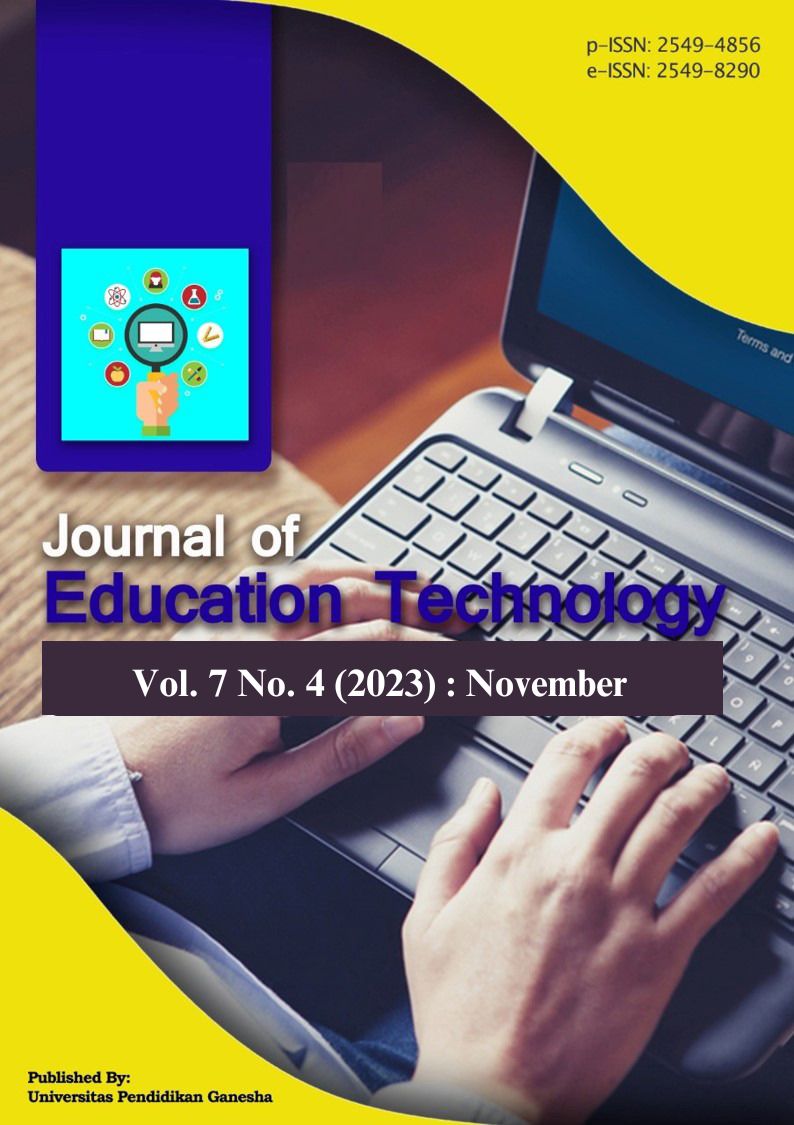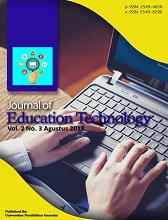Examining the Roles of Self-Efficacy, Attitude and Self-Regulated Learning through Augmented Reality in Reading for EFL Learners
DOI:
https://doi.org/10.23887/jet.v7i4.64567Keywords:
Relationship, Self-Efficacy, Attitude, Self-Regulated Learning, Augmented RealityAbstract
In recent years, higher education institutions have faced challenges in the field of education. The impact of digital technology such as augmented reality increases the possibility of self -regulated learning. Therefore this study analyze the relationship between self-efficacy, attitude and self-regulated learning across cognition, motivation, behaviour, and context through augmented reality in reading for English as foreign language (EFL) learners. Data were collected from 213 undergraduate students in English for Specific Class (ESP) in an academic university in Indonesia. This study was used a non-experimental, analytic survey research design with SmartPLS. The study assessed the measurement model of the factor loadings, composite reliability, and convergent validity, and employed bootstrapping for p-values of the path coefficient. The findings of the study reported that self-efficacy has a statistically significant relationship with cognition, motivation, behaviour and context while attitude has a statistically positive relationship with motivation and context but not with cognition and behavior.
References
Ajzen, I. (2012). Martin Fishbein’s Legacy: The Reasoned Action Approach. The ANNALS of the American Academy of Political and Social Science, 640(1), 11–27. https://doi.org/https://doi.org/10.1177/0002716211423363.
Alhamami, M. (2022). Language Learners’ Attitudes Toward Online and Face-To-Face Language Environments. Frontiers in Psychology, 13(July), 1–12. https://doi.org/10.3389/fpsyg.2022.926310.
Alsowat, H. H. (2016). Breaking down the Classroom Walls: Augmented Reality Effect on EFL Reading Comprehension, Self-Efficacy, Autonomy and Attitudes. Studies in English Language Teaching, 5(1), 1. https://doi.org/10.22158/selt.v5n1p1.
An, Z., Wang, C., Li, S., Gan, Z., & Li, H. (2021). Technology-Assisted Self-Regulated English Language Learning: Associations With English Language Self-Efficacy, English Enjoyment, and Learning Outcomes. Frontiers in Psychology, 11(January). https://doi.org/10.3389/fpsyg.2020.558466.
Bandura, A. (1977). Self-efficacy: The exercise of control. Freeman.
Benson, P. (2001). Teaching and Researching Learner Autonomy in Language Learning. Longman.
Çelik, F., & Yangın Ersanlı, C. (2022). The use of augmented reality in a gamified CLIL lesson and students’ achievements and attitudes: a quasi-experimental study. Smart Learning Environments, 9(1). https://doi.org/10.1186/s40561-022-00211-z.
Chang, H. Y., Binali, T., Liang, J. C., Chiou, G. L., Cheng, K. H., Lee, S. W. Y., & Tsai, C. C. (2022). Ten years of augmented reality in education: A meta-analysis of (quasi-) experimental studies to investigate the impact. Computers and Education, 191(August), 104641. https://doi.org/10.1016/j.compedu.2022.104641.
Cheng, K. H. (2017). Reading an augmented reality book: An exploration of learners’ cognitive load, motivation, and attitudes. Australasian Journal of Educational Technology, 33(4), 53–69. https://doi.org/10.14742/ajet.2820.
Cong, W., & Li, P. (2022). The Relationship Between EFL Learners’ Communication Apprehension, Self-Efficacy, and Emotional Intelligence. Frontiers in Psychology, 13, 294. https://doi.org/10.3389/FPSYG.2022.847383/BIBTEX.
Davis, F. D., Andrina Granić, & Nikola Marangunić. (2020). The Technology Acceptance Model 30 Years of TAM. Springer Cham.
Dishon, G., & Gilead, T. (2020). Adaptability And Its Discontents : 21st- Century Skills And The Preparation For An Unpredictable Future. British Journal of Educational Studies, 00(00), 1–21. https://doi.org/10.1080/00071005.2020.1829545.
Djamdjuri, D. S., Furqon, M., & Habibah, W. N. (2014). The Effects of Infographic to Enhance Students ’ Comprehension on Writing Descriptive Text. Indonesian Technology Enhanced Language Learning, 6(2), 57–63. https://online-journal.unja.ac.id/IJoLTE/article/view/23721.
Ebadi, S., & Ashrafabadi, F. (2022). An exploration into the impact of augmented reality on EFL learners’ Reading comprehension. Education and Information Technologies, 27, 1–21. https://doi.org/10.1007/s10639-022-11021-8.
Garzón, J., & Acevedo, J. (2019). Meta-analysis of the impact of Augmented Reality on students’ learning gains. Educational Research Review, 27(April), 244–260. https://doi.org/10.1016/j.edurev.2019.04.001.
Getie, A. S. (2020). Factors affecting the attitudes of students towards learning English as a foreign language. Http://Www.Editorialmanager.Com/Cogentedu, 7(1). https://doi.org/10.1080/2331186X.2020.1738184.
Goeltz, J. C., & Cuevas, L. A. (2021). Guided inquiry activity for teaching titration through total titratable Acidity in a general chemistry laboratory course. Journal of Chemical Education, 98(3), 882–887. https://doi.org/10.1021/acs.jchemed.0c01198.
Graham, S. (2022). Self-efficacy and language learning–what it is and what it isn’t. Language Learning Journal, 50(2), 186–207. https://doi.org/10.1080/09571736.2022.2045679.
Hadid, A., Mannion, P., & Khoshnevisan, B. (2019). Augmented reality to the rescue of language learners. Florida Journal of Educational Research, 57(2), 81–89. https://journals.flvc.org/fjer/article/view/133590.
Hair, J. J. F., Hult, G. T. M., Ringle, M., & Sarstedt, M. (2017). A primer on partial least squares structural equation modeling (PLS-SEM (2nd ed.). Sage Publication.
Irving, K. E. (2006). The impact of technology on the 21st century. Teaching Science in the 21st Century, March 1981, 3–19. https://cmapsconverted.ihmc.us/rid=1JVHR9TKT-1VMCFZP-SHW/21st century.pdf.
Jamrus, M. H. M., & Razali, A. B. (2019). Augmented Reality in Teaching and Learning English Reading: Realities, Possibilities, and Limitations. International Journal of Academic Research in Progressive Education and Development, 8(4), 724–737. https://doi.org/10.6007/ijarped/v8-i4/6696.
Kibirige, I., & Teffo, W. L. (2014). Actual and Ideal Assessment Practices in South African Natural Sciences Classrooms. International Journal of Educational Sciences, 6(3), 509–519. https://doi.org/10.31901/24566322.2014/06.03.1.
Lai, J. Y., & Chang, L. T. (2021). Impacts of Augmented Reality Apps on First Graders’ Motivation and Performance in English Vocabulary Learning. SAGE Open, 11(4). https://doi.org/10.1177/21582440211047549.
Muhammad, R., Khan, I., Ali, A., Kumar, T., Muhammad, R., Khan, I., Ali, A., Kumar, T., & Venugopal, A. (2023). Assessing the efficacy of augmented reality in enhancing EFL vocabulary. Cogent Arts & Humanities, 10(1). https://doi.org/10.1080/23311983.2023.2223010.
Nguyen, Q. N., Pham, L. N., & Nguyen, H. T. T. (2022). Tasks, self-efficacy, and L2 motivational self system in an online emergency EFL speaking class: A mixed-methods study. Jalt Call, 17(1), 31–63. https://doi.org/https://doi.org/10.29140/jaltcall.v18n1.518.
Olubode, O. C., Aderogba, O. A., & Ochayi, O. A. (2022). Undergraduate Students ’ Cognizance of Technologies for Self- Regulated Learning. Indonesian Journal Of Educational Research and Review, 5, 169–180. https://doi.org/10.23887/ijerr.v5i1.45192.
Pan, X. (2020). Technology Acceptance , Technological Self-Efficacy , and Attitude Toward Technology-Based Self-Directed Learning : Learning Motivation as a Mediator. 11(October). https://doi.org/10.3389/fpsyg.2020.564294.
Panadero, E. (2017). A Review of Self-regulated Learning: Six Models and Four Directions for Research. Frontiers in Psychology, 8(422), 1–28. https://doi.org/10.3389/fpsyg.2017.00422.
Pintrich, P. . (2004). A Conceptual Framework for Assessing Motivation and Self-Regulated Learning in College Students. Educational Psychology Review, 16, 385–407. https://doi.org/https://doi.org/10.1007/s10648-004-0006-x.
R.C. Gardner. (2006). Motivation and Attitudes in Second Language Learning. In Keith Brown (Ed.), Encyclopedia of Language & Linguistics (Second Edition) (pp. 348–355). Elsevier. https://doi.org/https://doi.org/10.1016/B0-08-044854-2/00625-8.
Schunk, D. H., & DiBenedetto, M. K. (2021). Self-efficacy and human motivation. In Advances in Motivation Science (1st ed., Vol. 8, pp. 153–179). Elsevier Inc. https://doi.org/10.1016/bs.adms.2020.10.001.
Sirakaya, M., & Cakmak, E. K. (2018). Effects of augmented reality on student achievement and self-efficacy in vocational education and training. International Journal for Research in Vocational Education and Training, 5(1), 1–18. https://doi.org/10.13152/IJRVET.5.1.1.
Siti, C., Md, L., Nur, L., Binti, D., Mohd, I., Afiq, D., & Tazilah, K. (2021). Application of technology acceptance model (TAM) toward online learning during covid-19 pandemic: Accounting students perspective. International Journal of Business, Economics and Law, 24(1), 13–20. https://www.researchgate.net/profile/mohd-khamar-tazilah/publication/349214593_application_of_technology_acceptance_model_tam_towards_online_learning_during_covid-19_pandemic_accounting_students_perspective/links/602547eaa6fdcc37a81d2da3/application-of-te.
Su, Y. S., Lai, C. C., Wu, T. K., & Lai, C. F. (2022). The effects of applying an augmented reality English teaching system on students’ STEAM learning perceptions and technology acceptance. Frontiers in Psychology, 13(October), 1–9. https://doi.org/10.3389/fpsyg.2022.996162.
Supriyono, Y., Saukah, A., Latief, M. A., & Widiati, U. (2020). EFL Learners ’ Learning in a Technology-Mediated Language Learning Setting. International Journal of Innovation, Creativity and Change, 10(10), 270–285. https://repository.uinjkt.ac.id/dspace/handle/123456789/67613.
Torrington, J., Bower, M., & Burns, E. C. (2023). Elementary Students’ Self-Regulation in Computer-Based Learning Environments: How do self-report measures, observations and teacher rating relate to task performance? British Journal of Educational Technology, April, 1–28. https://doi.org/10.1111/bjet.13338.
Ustun, A. B., Simsek, E., Yilmaz, F. G. K.-, & Yilmaz, R. (2022). The effects of AR-enhanced English Language Learning Experience on Students’ Attitudes, Self-Efficacy and Motivation. TechTrends, 66, pages798–809. https://doi.org/798–809 (2022). https://doi.org/10.1007/s11528-022-00757-2.
Vagg, T., Balta, J. Y., Bolger, A., & Lone, M. (2020). Multimedia in Education: What do the Students Think? Health Professions Education, 6(3), 325–333. https://doi.org/doi.org/10.1016/j.hpe.2020.04.011.
Verdinelli, S., & Scagnoli, N. I. (2013). Data display in qualitative research. International Journal of Qualitative Methods, 12(1), 359–381. https://doi.org/10.1177/160940691301200117.
Winarno, A., Fedin, M. Y. A., & Salleh, N. H. M. (2022). the Effect of Technological Literacy, Learning Facility, and Family Environment on Students’ Learning Motivation. Jurnal Pendidikan: Teori, Penelitian, Dan Pengembangan, 7(7), 246. https://doi.org/10.17977/jptpp.v7i7.15404.
Yulian, R., Yuniarti, Y., & Lee, N. A. B. A. (2022). Technology acceptance of augmented reality to attitude and self-efficacy in learning English. Journal of English Language Teaching Innovations and Materials (Jeltim), 4(2), 127–143. https://doi.org/10.26418/JELTIM.V4I2.56212.
Zhang, Y. (2022). The Effect of on Educational Technology on EFL Learners’ Self-Efficacy. Frontiers in Psychology, 13(April), 1–8. https://doi.org/10.3389/fpsyg.2022.881301.
Downloads
Published
How to Cite
Issue
Section
License
Copyright (c) 2023 Ryani Yulian, Yuniarti, Okta

This work is licensed under a Creative Commons Attribution-ShareAlike 4.0 International License.
Authors who publish with the Journal of Education Technology agree to the following terms:
- Authors retain copyright and grant the journal the right of first publication with the work simultaneously licensed under a Creative Commons Attribution License (CC BY-SA 4.0) that allows others to share the work with an acknowledgment of the work's authorship and initial publication in this journal.
- Authors are able to enter into separate, additional contractual arrangements for the non-exclusive distribution of the journal's published version of the work (e.g., post it to an institutional repository or publish it in a book), with an acknowledgment of its initial publication in this journal.
- Authors are permitted and encouraged to post their work online (e.g., in institutional repositories or on their website) prior to and during the submission process, as it can lead to productive exchanges, as well as earlier and greater citation of published work. (See The Effect of Open Access)


















